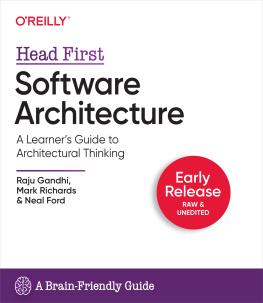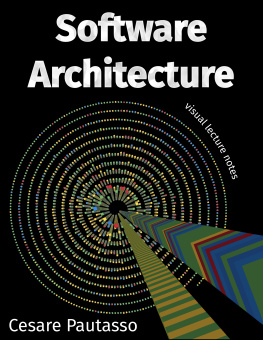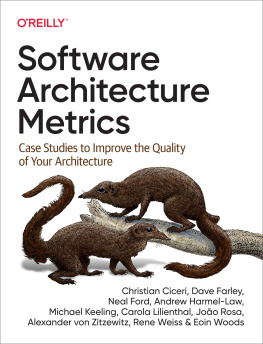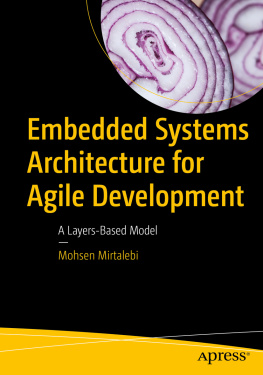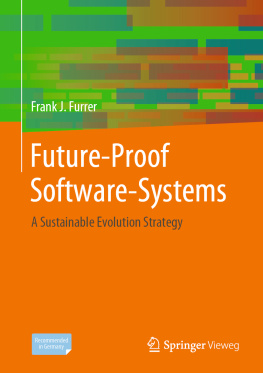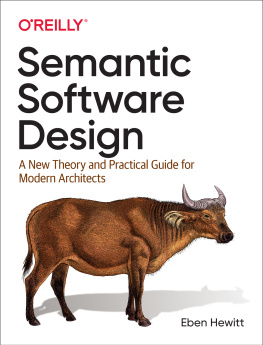Nick RozanskiEóin Woods - Software Systems Architecture
Here you can read online Nick RozanskiEóin Woods - Software Systems Architecture full text of the book (entire story) in english for free. Download pdf and epub, get meaning, cover and reviews about this ebook. year: 2012, publisher: Pearson Education Limited (US titles), genre: Computer. Description of the work, (preface) as well as reviews are available. Best literature library LitArk.com created for fans of good reading and offers a wide selection of genres:
Romance novel
Science fiction
Adventure
Detective
Science
History
Home and family
Prose
Art
Politics
Computer
Non-fiction
Religion
Business
Children
Humor
Choose a favorite category and find really read worthwhile books. Enjoy immersion in the world of imagination, feel the emotions of the characters or learn something new for yourself, make an fascinating discovery.

- Book:Software Systems Architecture
- Author:
- Publisher:Pearson Education Limited (US titles)
- Genre:
- Year:2012
- Rating:3 / 5
- Favourites:Add to favourites
- Your mark:
- 60
- 1
- 2
- 3
- 4
- 5
Software Systems Architecture: summary, description and annotation
We offer to read an annotation, description, summary or preface (depends on what the author of the book "Software Systems Architecture" wrote himself). If you haven't found the necessary information about the book — write in the comments, we will try to find it.
Software Systems Architecture — read online for free the complete book (whole text) full work
Below is the text of the book, divided by pages. System saving the place of the last page read, allows you to conveniently read the book "Software Systems Architecture" online for free, without having to search again every time where you left off. Put a bookmark, and you can go to the page where you finished reading at any time.
Font size:
Interval:
Bookmark:
Working with Stakeholders Using Viewpoints and Perspectives
Second Edition
Nick Rozanski
Eoin Woods

Upper Saddle River, NJ Boston Indianapolis San Francisco
New York Toronto Montreal London Munich Paris Madrid
Capetown Sydney Tokyo Singapore Mexico City
Many of the designations used by manufacturers and sellers to distinguish their products are claimed as trademarks. Where those designations appear in this book, and the publisher was aware of a trademark claim, the designations have been printed with initial capital letters or in all capitals.
The authors and publisher have taken care in the preparation of this book, but make no expressed or implied warranty of any kind and assume no responsibility for errors or omissions. No liability is assumed for incidental or consequential damages in connection with or arising out of the use of the information or programs contained herein.
The publisher offers excellent discounts on this book when ordered in quantity for bulk purchases or special sales, which may include electronic versions and/or custom covers and content particular to your business, training goals, marketing focus, and branding interests. For more information, please contact:
U.S. Corporate and Government Sales
(800) 382-3419
For sales outside the United States please contact:
International Sales
Visit us on the Web:
Library of Congress Cataloging-in-Publication Data
Rozanski, Nick.
Software systems architecture : working with stakeholders using viewpoints and
perspectives / Nick Rozanski, Eoin Woods. 2nd ed.
p. cm.
Includes bibliographical references and index.
ISBN 0-321-71833-X (hard cover : alk. paper)
1. Computer software Development. 2. Computer architecture. I. Woods, Eoin. II. Title.
QA76.76.D47R696 2012
005.3 dc23
2011040253
Copyright 2012 Pearson Education, Inc.
All rights reserved. Printed in the United States of America. This publication is protected by copyright, and permission must be obtained from the publisher prior to any prohibited reproduction, storage in a retrieval system, or transmission in any form or by any means, electronic, mechanical, photocopying, recording, or likewise. To obtain permission to use material from this work, please submit a written request to Pearson Education, Inc., Permissions Department, One Lake Street, Upper Saddle River, New Jersey 07458, or you may fax your request to (201) 236-3290.
ISBN-13: 978-0-321-71833-4
ISBN-10: 0-321-71833-X
Text printed in the United States on recycled paper at Courier in Westford, Massachusetts.
First printing, October 2011
To my family, Isabel, Sophie, Alex, and Luci
NR
To my parents, Anne and Desmond,
and to my family, Lynda and Katherine
EW
The IT landscape looks significantly different today from when we first started work on our book ten years ago. The world is a much more connected place, with computers and the Internet being a big part of many peoples daily lives both at home and at work. This has led to an even greater expectation among users and other stakeholders that systems should be functionally rich and complete, easy to use, robust, scalable, and secure. We feel that the architect has an important role in achieving these goals and are heartened by the fact that this view seems to have gained fairly widespread acceptance among software development professionals and senior business and technology management.
We were delighted by the positive reception to the first edition of our book from practitioners, aspiring software architects, and academia. Our readers seemed to find it useful, comprehensive, and informative. However, architecture is a constantly changing discipline, and the second edition reflects what we have learned and improved upon in our own practice since the publication of the first edition. It also incorporates a number of very useful comments and suggestions for improvement from readers, for which we are extremely grateful.
However, our fundamental messages remain the same. Our primary focus is on architecture as a service to stakeholders and a way to ensure that an information system meets their needs. We continue to emphasize the vital importance of views as a way of representing an architectures complexity in a way its stakeholders can understand. We are also unswerving in our belief that architecture must define how a system will provide the required quality propertiessuch as scalability, resilience, and securityas well as defining its static and dynamic structure, and that perspectives provide an effective way to do this.
Our main audience is practicing or aspiring architects, but we hope that other IT professionals, who may be working alongside an architect, and students, who will one day find themselves in this position, will also find it a useful read.
The most important changes in this edition are as follows.
We have introduced a new viewpoint, which we call the Context viewpoint. This describes the relationships, dependencies, and interactions between the system and its environment (the people, systems, and external entities with which it interacts). It extends, formalizes, and standardizes the relatively brief discussion of scope and context that used to be in .
We have expanded the discussion of different aspects of the role of architecture in .
We have revised most of the viewpoint and perspective definitions, particularly the Functional and Concurrency views and the Performance and Scalability perspective.
We have revised and extended the Bibliography and the Further Reading sections in most chapters.
We have updated the book to align with the concepts and terminology in the new international architecture standard ISO 42010 (which derives from IEEE Standard 1471).
We have updated our UML modeling advice and examples to reflect the changes introduced in version 2 of UML.
We hope that you find the second edition of the book a useful improvement and extension of the first edition, and we invite you to visit to our Web site at www.viewpoints-and-perspectives.info for further software architecture resources or to contact us to provide feedback on the book.
In addition to the people we thanked for the first edition, we would also like to thank our second-edition reviewersPaul Clements, Tim Cull, Rich Hilliard, Philippe Kruchten, and Tommi Mikkonenand our diligent and thorough copy editor, Barbara Wood. In particular, we would like to thank Paul for his thorough, insightful, and challenging comments and suggestions for improvement, which we found extremely useful.
The authors of this book are both practicing software architects who have worked in this role, together and separately, on information system development projects for quite a few years. During that time, we have seen a significant increase in the visibility of software architects and in the importance with which our role has been viewed by colleagues, management, and customers. No large software development project nowadays would expect to go ahead without an architector a small architectural groupin the vanguard of the development team.
While there may be an emerging consensus that the software architects role is an important one, there seems to be little agreement on what the job actually involves. Who are our clients? To whom are we accountable? What are we expected to deliver? What is our involvement once the architectural design has been completed? And, perhaps most fundamentally, where are the boundaries between requirements, architecture, and design?
Font size:
Interval:
Bookmark:
Similar books «Software Systems Architecture»
Look at similar books to Software Systems Architecture. We have selected literature similar in name and meaning in the hope of providing readers with more options to find new, interesting, not yet read works.
Discussion, reviews of the book Software Systems Architecture and just readers' own opinions. Leave your comments, write what you think about the work, its meaning or the main characters. Specify what exactly you liked and what you didn't like, and why you think so.

